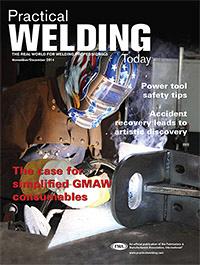President
- FMA
- The Fabricator
- FABTECH
- Canadian Metalworking
Categories
- Additive Manufacturing
- Aluminum Welding
- Arc Welding
- Assembly and Joining
- Automation and Robotics
- Bending and Forming
- Consumables
- Cutting and Weld Prep
- Electric Vehicles
- En Español
- Finishing
- Hydroforming
- Laser Cutting
- Laser Welding
- Machining
- Manufacturing Software
- Materials Handling
- Metals/Materials
- Oxyfuel Cutting
- Plasma Cutting
- Power Tools
- Punching and Other Holemaking
- Roll Forming
- Safety
- Sawing
- Shearing
- Shop Management
- Testing and Measuring
- Tube and Pipe Fabrication
- Tube and Pipe Production
- Waterjet Cutting
Industry Directory
Webcasts
Podcasts
FAB 40
Advertise
Subscribe
Account Login
Search
Aluminum Workshop: Aluminum MIG welding fumes
- By Frank Armao
- Updated August 8, 2023
- November 21, 2014
- Article
- Aluminum Welding
Q: I just started gas metal arc welding (GMAW) aluminum in my shop. I have noticed that a lot of white smoke comes off when I weld. Is this dangerous? Are there other issues with fumes I need to be aware of when welding aluminum? How concerned should I be?
A: You are absolutely doing the right thing in trying to find out the facts about welding fume, whether welding aluminum or any other material. The aluminum alloys produce much more visible welding fume (the white smoke that you see) than many other materials. This is especially true in GMAW. It is not as apparent when performing gas tungsten arc welding (GTAW) on aluminum. This happens because in GMAW we are transferring metal across the arc. In doing this, a good bit of material evaporates and forms the visible fume. In GTAW the filler wire doesn’t get as hot, so much less material evaporates and creates fume.
Is Welding Aluminum Toxic
I have some good news for you. Although the process produces a lot of white fume, it consists almost entirely of magnesium oxide and aluminum oxide, which are considered to be merely lung irritants. I won’t kid you, both substances will irritate your lungs, so you shouldn’t breathe them if you can avoid it. However, they don’t contain anything that would adversely affect your health long term, unlike fume produced when welding other materials. There is no beryllium in aluminum filler welds, nor is there any manganese, chromium, or nickel.
In fact, the fume given off aluminum welding has been rather well-researched. Four different comprehensive studies were conducted under the sponsorship of the Aluminum Association in Arlington, Va. Any or all of them are available for purchase if you are interested.
Ozone Gas in Aluminum MIG Welding Fumes
There is one aspect of weld fume that I haven’t discussed, and that is the formation of ozone gas (O3). You are all familiar with this gas because it produces the smell in the air after a thunderstorm. Because of the high currents and pure argon shielding gas used in welding aluminum, large amounts of ozone can be produced. Ozone is considered to be a lung irritant, so much so that federal standards limit how much ozone can be present in the air. It may be necessary to install ventilation systems to remove ozone from the welding area, especially if you weld in an area that isn’t well-ventilated.
This article is by no means comprehensive and was not meant to be. I’ve only attempted to address items specifically related to fume generated when welding aluminum here. I have not discussed any other aspect of welding fume or protecting yourself from it. Make sure that you are familiar with the required safety precautions and are protecting yourself properly.
About the Author

Frank Armao
Aluminum Consulting Inc.
440-479-0239
About the Publication
Related Companies
subscribe now

The Welder, formerly known as Practical Welding Today, is a showcase of the real people who make the products we use and work with every day. This magazine has served the welding community in North America well for more than 20 years.
start your free subscription- Stay connected from anywhere

Easily access valuable industry resources now with full access to the digital edition of The Fabricator.

Easily access valuable industry resources now with full access to the digital edition of The Welder.

Easily access valuable industry resources now with full access to the digital edition of The Tube and Pipe Journal.
- Podcasting
- Podcast:
- The Fabricator Podcast
- Published:
- 04/16/2024
- Running Time:
- 63:29
In this episode of The Fabricator Podcast, Caleb Chamberlain, co-founder and CEO of OSH Cut, discusses his company’s...
- Trending Articles
Sheffield Forgemasters makes global leap in welding technology

ESAB unveils Texas facility renovation

Engine-driven welding machines include integrated air compressors

The impact of sine and square waves in aluminum AC welding, Part I

Compact weld camera monitors TIG, plasma processes

- Industry Events
16th Annual Safety Conference
- April 30 - May 1, 2024
- Elgin,
Pipe and Tube Conference
- May 21 - 22, 2024
- Omaha, NE
World-Class Roll Forming Workshop
- June 5 - 6, 2024
- Louisville, KY
Advanced Laser Application Workshop
- June 25 - 27, 2024
- Novi, MI



























